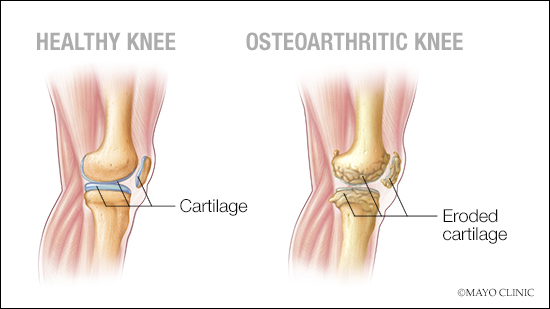-
Mayo Clinic Q and A: Treating osteoarthritis with corticosteroid injections

DEAR MAYO CLINIC: I have osteoarthritis in my knee that continues to worsen. Would a steroid injection help my knee pain? How long does the treatment last, and how often can it be repeated, if necessary?
ANSWER: Corticosteroid medications are powerful drugs that can be useful in decreasing pain and inflammation in various musculoskeletal conditions, including joint problems such as osteoarthritis. Depending on your health and the severity of your symptoms, the effects of a corticosteroid injection can vary quite a bit. If the injection decreases or eliminates your pain, you may be able to get another injection if your symptoms return. Because of the possibility of serious side effects, though, the number of injections — and how often you can receive them — is limited.
A corticosteroid shot helps relieve joint pain by decreasing inflammation in and around a joint. These medications are used in people who have osteoarthritis because the disease frequently leads to joint pain, tenderness and swelling, especially in the hands, knees, hips and spine. The injections also are commonly prescribed for people who have pain due to other disorders, such as tendinitis, carpal tunnel syndrome, gout, bursitis and rheumatoid arthritis.
Getting a corticosteroid shot usually does not require an overnight stay. Rather, an office visit to your health care provider usually will suffice. Before the injection, the area around the injection site is cleaned thoroughly with a special cleaning solution. Your health care provider may apply an anesthetic spray to numb the area where the needle is inserted. To make sure the needle is placed correctly, your health care provider may use ultrasound or a type of X-ray called fluoroscopy to watch where the needle goes inside your body.
After the needle is inserted, the medication is released into the injection site. Typically, these shots include the corticosteroid medication to relieve pain and inflammation over time, as well as an anesthetic to provide immediate pain relief.
How long the pain relief from a corticosteroid injection lasts depends largely on your individual health situation. For some people, the effects may last only a week or two. Ohers may be symptom-free for several months or more.
Corticosteroids can effectively relieve symptoms such as joint pain, tenderness, and stiffness, but they are not without risks. For some people, the shot may cause a flare of pain and inflammation in the joint just after it is given. In most cases, these symptoms fade within 48 hours of receiving the injection.
Although uncommon, longer-lasting complications can include nerve damage, joint infection, damage to nearby tendons, and thinning of the cartilage and bones near the injection site. Some people may have temporary pain relief due to the numbing medicine commonly used with these shots but not long-term pain relief. Also, people who take blood thinners to treat stroke, and heart or clotting disorders, may not be able to receive corticosteroid injections safely while on those medications.
Some evidence indicates that repeated corticosteroid shots do not change the way arthritis in the spine progresses over time. Chronic use of the shots eventually can cause cartilage within a joint to deteriorate, resulting in permanent joint damage. Because of that, these injections usually are not given more often than once every six weeks. It also typically is recommended that people receive corticosteroid injections no more than three or four times a year.
Review the benefits and risks of a corticosteroid injection with your health care provider to help you decide if it's right for your situation. — Dr. George Pujalte, Family Medicine and Sports Medicine, Mayo Clinic, Jacksonville, Florida
****************************
Related Articles
- Mayo Clinic Q and A: Understanding osteoarthritis and rheumatoid arthritis published 1/4/19
- Mayo Clinic Radio: Osteoarthritis published 1/3/19
- Mayo Clinic Minute: Finding relief for osteoarthritis pain published 3/19/18







